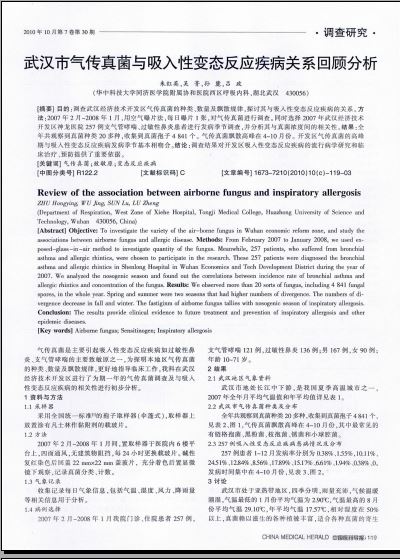武汉市气传真菌与吸入性变态反应疾病关系回顾分析
 |
| 第1页 |
参见附件(2057KB,3页)。
[摘要] 目的:调查武汉经济技术开发区气传真菌的种类、数量及飘散规律,探讨其与吸入性变态反应疾病的关系。方法:2007年2月~2008年1月,用空气曝片法,每日曝片1张,对气传真菌进行调查。同时选择2007年武汉经济技术开发区神龙医院257例支气管哮喘、过敏性鼻炎患者进行发病季节调查,并分析其与真菌浓度间的相关性。结果:全年共观察到真菌种类20多种,收集到真菌孢子4 841个。气传真菌飘散高峰在4~10月份。开发区气传真菌的高峰期与吸入性变态反应疾病发病季节基本相吻合。结论:调查结果对开发区吸入性变态反应疾病的流行病学研究和临床治疗、预防提供了重要依据。
[关键词] 气传真菌;致敏原;变态反应疾病
[中图分类号] R122.2[文献标识码] C [文章编号] 1673-7210(2010)10(c)-119-03
Review of the association between airborne fungus and inspiratory allergosis
ZHU Hongying, WU Jing, SUN Lu, LU Zheng
(Department of Respiration, West Zone of Xiehe Hospital, Tongji Medical College, Huazhong University of Science and Technology, Wuhan 430056, China)
[Abstract] Objective: To investigate the variety of the air-borne fungus in Wuhan economic reform zone, and study the associations between airborne fungus and allergic disease. Methods: From February 2007 to January 2008, we used exposed-glass-in-air method to investigate quantity of the fungus. Meanwhile, 257 patients, who suffered from bronchial asthma and allergic rhintics, were chosen to participate in the research. These 257 patients were diagnosed the bronchial asthma and allergic rhintics in Shenlong Hospital in Wuhan Economics and Tech Development District during the year of 2007. We analyzed the nosogenic season and found out the correlations between incidence rate of bronchial asthma and allergic rhintics and concentration of the fungus. Results: We observed more than 20 sorts of fungus, including 4 841 fungal spores, in the whole year. Spring and summer were two seasons that had higher numbers of divergence. The numbers of divergence decrease in fall and winter. The fastiginm of airborne fungus tallies with nosogenic season of inspiratory allergosis. Conclusion: The results provide clinical evidence to future treatment and prevention of inspiratory allergosis and other epidemic diseases.
[Key words] Airborne fungus; Sensitinogen; Inspiratory allergosis
气传真菌是主要引起吸入性变态反应疾病如过敏性鼻炎、支气管哮喘的主要致敏原之一,为探明本地区气传真菌的种类、数量及飘散规律,更好地指导临床工作,我科在武汉经济技术开发区进行了为期一年的气传真菌调查及与吸入性变态反应疾病的相关性进行初步分析。
1 资料与方法
1.1 采样器
采用全国统一标准[1]的孢子取样器(伞蓬式),取样器上放置涂有凡士林作黏附剂的载玻片。
1.2 方法
2007年2月~2008年1月间,置取样器于医院内6楼平台上,四面通风,无建筑物阻挡,每24小时更换载玻片。碱性复红染色后回盖22 mm×22 mm盖玻片,充分着色后置显微镜下观察,记录真菌分类、计数。
1.3 气象记录
收集记录每日气象信息,包括气温、湿度、风力、降雨量等相关信息用于分析。
1.4 病例选择
2007年2月~2008年1月我院门诊、住院患者257例,支气管哮喘121例,过敏性鼻炎136例;男167例,女90例;年龄10~71岁。
2 结果
2.1 武汉地区气象资料
武汉市地处长江中下游,是我国夏季高温城市之一,2007年全年月平均气温值和年平均值详见表1。
2.2 武汉市气传真菌种类及分布
全年共观察到真菌种类20多种,收集到真菌孢子4 841个,见表2、图1,气传真菌飘散高峰在4~10月份,其中最常见的有链格孢菌、黑粉菌、枝孢菌、锈菌和小球腔菌。
2.3 257例吸入性变态反应疾病患病情况及分布
257例患者1~12月发病率分别为0.38%、1.55%,10.11%、24.51%、12.84%、8.56%、17.89%、15.17%、6.61%、1.94%、0.38%、0。发病时间集中在4~10月份,见表3、图2。
3 讨论
武汉市处于亚热带地区,四季分明,雨量充沛,气候温暖潮湿,气温最低的1月份平均气温为2.90℃,气温最高的8月份平均气温29.10℃ ......
您现在查看是摘要介绍页,详见PDF附件(2057KB,3页)。